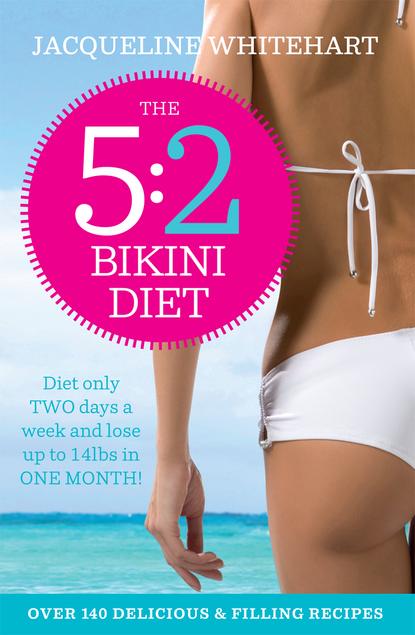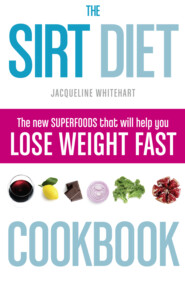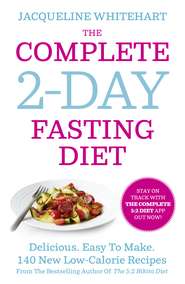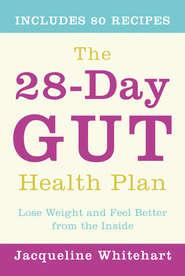По всем вопросам обращайтесь на: info@litportal.ru
(©) 2003-2024.
✖
The 5:2 Bikini Diet: Over 140 Delicious Recipes That Will Help You Lose Weight, Fast! Includes Weekly Exercise Plan and Calorie Counter
Автор
Год написания книги
2018
Настройки чтения
Размер шрифта
Высота строк
Поля
If you have followed the 5:2 diet before you will be familiar with the term ‘feast’ day, but that’s something that trips people up time and time again. This is because most of us, if told we can eat what we like, go a bit mad.
The five non-fast days are normal and healthy days, they are not diet days and we do not count calories.
DO:
• Enjoy your food and don’t count the calories.
• Eat three healthy meals a day.
• Do NOT snack between meals and avoid processed food.
Cut out the rubbish. Keep the following items to a very bare minimum:
• biscuits (cookies) and cakes
• crisps (potato chips)
• non-diet fizzy drinks
• chocolate bars and sweets (candies)
• beer, lager and cider
If you follow these steps, you will have plenty of scope for tasty plates of food without excluding any food group, and it means that you will be able to have delicious pasta, bread, desserts and, of course, a glass or two of wine.
Remember that the recipes in this book are not just for fast days; they are perfect for your normal days too. Just add some extra carbohydrates, such as rice or potatoes, if necessary and make sure you eat three balanced meals every day.
3 Exercise three times a week
While rules 1 and 2 are for weight loss, exercise makes the most of the weight loss by reducing the flab, toning your body and zapping the cellulite.
If you are new to exercise, then perhaps the best way to get started is walking. Start with walking 15 minutes a day, three days a week and work up from there. Walking is great if you are just starting to exercise as it is proven to significantly improve fitness levels. Walking increases the blood flow to the muscles, improving circulation and heart function. Swimming is also a suitable option if you are just getting started with exercise.
If you are fit and exercise regularly then you should find Sculpt’s 5:2 Bikini Diet exercise plan easy and enjoyable, ready to get your body in shape for the summer – fast!
By following the workout plan three times a week, you can expect great results in just four weeks. There’s more detail about the benefits of combining exercise with the 5:2 diet in the ‘Getting beach fit’ chapter (see here (#u3162ddf4-3307-40e3-bd0f-3bf85a268272)).
HEALTH BENEFITS (#ulink_91f32dd2-49e5-533b-85c5-c21765580b03)
Not just slimming
This chapter simply explains the medical reasons for the diet’s success. When you understand how healthy you will become on this diet – as well as slimming easily – you will keep to this lifestyle forever. The slimming results on the 5:2 Bikini Diet are stunning. And not just that, losing weight healthily and easily improves your overall health. There is also increasing evidence that this new breed of fast diet, of which the 5:2 diet is the easiest and most popular, has some incredible benefits for your long-term health too.
What happens in our bodies when we fast?
Based on the opinion of several fasting experts, there is now a picture developing of how the scientists believe intermittent fasting changes the way our bodies work, giving us additional health benefits as we age. Here I provide a simple approach to the science, which I hope will make it clearer to anyone with a general interest, but without a scientific background.
When we deprive our body of food for longer than normal, for example during a fast, we notice changes in some of our hormones. As the levels of certain hormones change, this has a knock-on effect on different types of cells within our body. One of these hormones, Insulin-like Growth Factor 1 (IGF-1), is proven to decrease as we fast. IGF-1 is produced in the liver and is similar to insulin. Its purpose in the body is to make cells grow and produce new cells. When levels of IGF-1 decrease, our body produces fewer new cells and concentrates on repairing old ones. This state of ‘repair’ is very beneficial as it slows down the ageing process and may reduce the risks of cancer, diabetes and heart disease.
Another hormone that fasting seems to affect is a nerve cell growth factor in the brain, which changes the way neurons in the brain grow. This research is in its infancy and has yet to be tested on humans, but there are several indicators that suggest this is the mechanism that ultimately leads to a reduction in risk factors for cognitive diseases such as Alzheimer’s.
There’s a final exciting difference between standard calorie-restricted diets and intermittent fasting. Any weight you lose doing intermittent fasting is body fat! If this is not a reason to do the 5:2 diet over anything else then I don’t know what is.
Other diets may show a decrease in body fat and muscle, but with intermittent fasting it seems to be just fat. Scientists are unsure at present why this is true, but it has been seen in a variety of studies so there is a good scientific basis for these findings. The most likely explanation is that when we fast, we have to use resources in our body (i.e. fat) for fuel rather than the food we have eaten. It may also be the key as to why the 5:2 diet is so successful for so many people.
Optimizing the benefits – do we need to skip meals?
The simple answer is yes. If your primary goal is health benefits, not weight loss, the science suggests you should eat only one meal on a fast day. Remember that how you consume calories over the fast day does not affect weight loss. Top scientists from the United States are in agreement that to get the absolute best out of intermittent fasting you need to either fast completely for 24 hours or, at most, have one small meal in the middle of the 24-hour period. The tests where they try other kinds of calorie restriction over the 24-hour period just haven’t been done yet, so it’s hard to tell for sure whether the science backs this up.
If you’re reading this and thinking, Help, there’s no way I can only eat once a day, then you’re not alone. And this is why I do not advocate skipping meals unless it’s something that appeals to you and it’s something you can see yourself sticking to in the long term.
First and foremost this is because it does not affect the rate at which you slim. If your main objective is to lose weight and gain the health benefits that come with sustained weight loss, then stick to the 500/600 calories on your fast days, but do not worry about when you eat them.
Secondly, although the health benefits may not be optimized, you are still getting some of them. You are fasting and your body is going into repair mode so don’t panic if you are not fully ‘optimized’. Is anything in your life fully optimized? I know it’s not the case for me.
Finally, and most importantly, what do you think is best: having a strict fast with only one meal but finding it so hard and de-motivating that you give up after a month or eating two or three small meals on your fast day and finding it sustainable in the long term?
I’d say the latter is by far the best option, but use your own preference. If you find it easier to skip a meal, then do so. I often, but not always, skip lunch on a fast day. But if three meals a day works for you then don’t change it. You are doing great as you are.
What’s in a name?
There are many different names for diets that are the same or similar to the 5:2 diet, so it’s no wonder people are getting confused.
The fast diet or 5:2 diet
These are, as far as anyone can tell, the same diet – just two names for the same thing. I think the double name comes from the origins of the diet. The 5:2 diet didn’t exist before a TV programme by Michael Mosley in August 2012. Many people, including myself, started following the simple principle of eating less two days per week. At this stage it didn’t have a name and as people were discussing it on Twitter and other social media sites it needed a name, so the simplest name stuck – the 5:2 diet. Later, as the diet became a phenomenon, marketing types got hold of it and it also became known as ‘the fast diet’. In the US, where the diet never grew through word of mouth, it seems to be just called ‘the fast diet’ or ‘the British fast diet’.
The 2-day diet
The 2-day diet has a totally different root to the 5:2 diet, despite its similarity in name and action.
The 2-day diet grew out of some amazing research by Dr Michele Harvie at the University of Manchester over the last few years. Harvie is a breast cancer specialist and has been looking at ways to reduce breast cancer risks through diet. She has done experiments with groups of overweight women, where she radically changed their diets just two days a week. The diet has many similarities to 5:2, in that you restrict calories two days a week and eat normally for five. But the calories are restricted to 650 for both men and women and the food eaten on a fast day is more prescriptive – it includes a certain amount of milk and is totally carbohydrate free (rather like the Atkins diet) on the fast days. Most contrastive to the 5:2 diet is that the two days must be consecutive.
Her research highlighted two important things. First, that dieting two days a week was easier and that more people stuck to it than dieting all the time. Harvie compared two groups of women. The first group fasted two days a week and the second group followed a standard calorie-restricted diet, sticking to 1500 calories a day. After three months of following the diets, the research showed that intermittent fasters were almost twice as likely to stick to their diet.
The second and most impressive finding of her research was the reduction in a breast-cancer-causing hormone called leptin, which was reduced on average by 40 per cent, and a drop in insulin levels of 25 per cent, cutting the diabetes risk in these women.
Alternate day fasting (ADF)
Alternate day fasting originated in the US before the fast diet became popular in the UK. The principles of this diet are very simple. A strict fast diet is followed every other day. It also restricts how many meals you eat in that one day. The 5:2 diet is a variation on this theme, allowing you to fast for fewer days in a week and also to take weekends off. They are similar in terms of weight loss and effects, although obviously you may lose weight faster on ADF. But the success rate (i.e. the number of people who stick to the diet in the long term) is lower.
There has been an interesting study in the US by Dr Varady into ADF. Varady’s research is fascinating. She took a group of both male and female overweight volunteers and started them on ADF for a year. This study is still progressing, but initial results in this case show a low dropout rate, gradual and continued weight loss and falls in both total and LDL (‘bad’) cholesterol.
Window or 8-hour fasting
Window fasting is a slightly different way of structuring your fast days. You fast for a part of your day, seven days a week. For example, a popular structure is that you fast from 8 p.m. on one day until 12 p.m. the following day. This means that your eating ‘window’ is 12 p.m. to 8 p.m. every day. Some people find that this kind of fasting fits more naturally into their lifestyle as they can eat a normal lunch and dinner every day, but it’s definitely not to everyone’s taste.
There has not been much research into this particular type of intermittent fasting, but the results are likely to be similar to that of 5:2 fasting or ADF.









